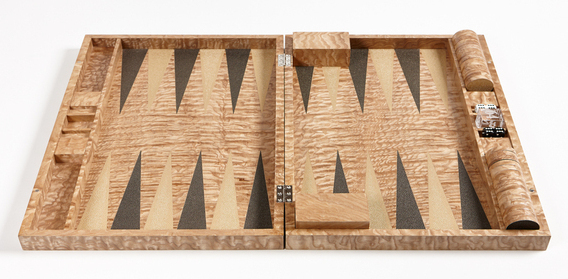BACKGAMMON: A HISTORY OF THE GAME
It is believed that backgammon originated in around 3000BC in the Persian Empire, and so Backgammon is seen to be the oldest recorded game in history – older even that chess! Recent archaeological digs have unearthed backgammon boards which are very similar to the boards we use today – with the oldest known board made of ebony featuring pieces of agate and turquoise. Backgammon was more typically played on hard surfaces such as wood, with markers made of stone, and dice made of bones, stones, wood or pottery. Variants of the game that we call Backgammon can be traced back to early cultures in China, India, Egypt, Greece and Rome where it was so popular it earnt the nickname “The Game of Kings”.
In Persia, the game was commonly called “Takhteh Nerd” (which translates roughly to “Battle on Wood”, and the original three dice used were reduced to just two. The game continued to spread in popularity across the world, and eventually reached Europe. The modern version of backgammon that we play today, supposedly comes from a 17th Century English game called “Tables” where doublets were played twice, and if your opponent failed to remove or get home any of their checkers you could win up to triple the stakes! “Tables” was a popular game for soldiers & traders to play during the medieval crusades, and the Church even tried to ban the game a few times but were never successful as people just scratched the board out of dirt and used pebbles for the pieces.
The fact that the Church tried to ban backgammon in the past, leads to an interesting design feature of the game that is still used today! When Cardinal Wolesley called Backgammon “The Devil’s Folly” and ordered all boards burnt, English craftsmen came up with a plan to disguise the boards by enabling them to be folded in half, which makes them almost look like a book! This clever design is still the standard way that backgammon boards are made to this day.
The exact origin of the word Backgammon isn’t really known, although there are similar words in both Welsh and Middle English. The Welsh version is baec (back) and cammaun (battle) whilst the Middle English is baec (back) and gamen (game). Either way, the term Backgammon seems to appear in the English language in the 1600s. Edmond Hoyle (1672 – 1769) was a writer who was best known for his books on the rules and play of card games, and in 1745 he published a pamphlet which outlined the rules of Backgammon and even gave some strategy tips which are still useable tips today. Backgammon continued to spread across the world and finally landed in America, thanks to the Settlers, where it became a usual home fixture alongside the other old favourite chess! Falling out of favour a little in the Victorian age, new interest and excitement about the game was sparked in the 1920s with the introduction of the doubling cube.
The doubling cube is believed to have been introduced to the game by an unknown gambler in New York City, in order to enhance the level of skill required in the game. This improved its marketability, and ensured that Backgammon again became a popular pastime. It became really popular in private clubs at the time, and publications dedicated to the game and strategies to win even began to be published. The rules of the game were modified in 1931 by the New York Racquet and Tennis Club, and these are the actual source of the standard rules which are still used internationally rode.
In March 1964, the first major international Backgammon tournament was organised in the Bahamas by Prince Alexis Obolensky (from Russia). This was the first Official World Backgammon Tournament, and the winning of it is Backgammon’s highest honour. Prince Obolensky was also known as the “Grandfather of Backgammon”, and he was the President of the World Backgammon Club until he passed away in 1986.
Backgammon is still a popular game throughout the world, and nowhere more so than in the Middle East. Millions of people play backgammon every day in Turkey, Greece, Bulgaria and Armenia. In fact, it is such a popular game in Greece that it is considered a national pastime, has three different variants for people to play, and a Greek tournament director recently suggested that around 90% of the population play the game!
In recent years, advances in technology have meant that the game has now moved online as well. Computers can now provide decent opponents for players, and also perform rollouts of positions which saves hours of time and also gives players a deeper understanding of the game. Today, with the internet, players can now connect to other players all over the world with just the click of a mouse – which has seen a revival in the interest in the game, and hopefully will stimulate a new golden era for backgammon.

